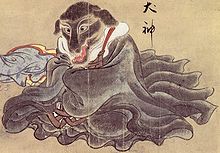Inugami (mythology)
Inugami , also Inukami ( Japanese 犬 神 , in German "dog god"), are creatures of Japanese mythology who are similar to Shikigami and belong to the group of Kami ( 神 ). They are powerful spirits .
description
Inugami are said to have a dog-like shape. They can be entirely animal-shaped or anthropomorphic , similar to a werewolf . Inugami is said to have certain black magic powers.
Lore
The first records about Inugami come from the Edo period (1603–1868).
According to Japanese folklore , an inugami must be conjured up. To do this, bury a dog up to its neck and place a bowl of food just out of reach of the snout. Days later, when the dog is about to die from starvation, its head should be cut off from behind and buried under a busy street. After a certain time it should be brought out again and opened in a prepared shrine . Now one should be able to call an Inugami.
Similar to the Shikigami , a soulful paper male kin , Inugami are summoned and hired for risky and criminal assignments, in particular for murder and mutilation of the victim. If the summoner is particularly well versed and experienced in his arts, he can call on Inugami, who take possession of their victims and drive them mad and let themselves be acted like mad. However, Inugami themselves are said to be very dangerous: Since their soul is driven by blind vindictiveness, it can quickly happen that they take revenge on their summoner instead of, as planned, venting their anger on the commissioned victim.
Families who keep Inugami are called Inugami mochi ( 犬 神 持 ち ; to German "who keep a dog god"). In these families it is a tradition to only marry with other Inugami mochi.
Inugami in the modern subculture
In 1976 the mystery thriller The Inugami Family ( 犬 神 家 の 一族 ) was directed by Kon Ichikawa . It is based on the novel of the same name by Seishi Yokomizo . The horror film Inugami - The Cursed by Masato Harada , also from Japan, was made in 2001 .
literature
- Takeshi Abe, Adam Beltz: The Negima Reader: Secrets Behind the Magic . DH Publishing Inc, 2007, ISBN 1932897240 , pp. 49-51.
- Stephen H. Sumida: And the View from the Shore: Literary Traditions of Hawaiʻi . University of Washington Press, 1991, ISBN 0295970782 , p. 228.
- Moku Jōya: Mock Jōya's Things Japanese . Japan Times, Tokyo 1985, pp. 408-412.
- Herbert E. Plutschow: A reader in Edo period travel . Global oriental, 2006, ISBN 1901903230 , pp. 16-19.
- Michaela Haustein: Mythologies of the World: Japan, Ainu, Korea epubli, Berlin 2011, ISBN 3844214070 , p. 19.
- Keiko I. McDonald: Reading a Japanese Film: Cinema in Context . University of Hawaii Press, Honolulu 2006, ISBN 082482993X , p. 11.

